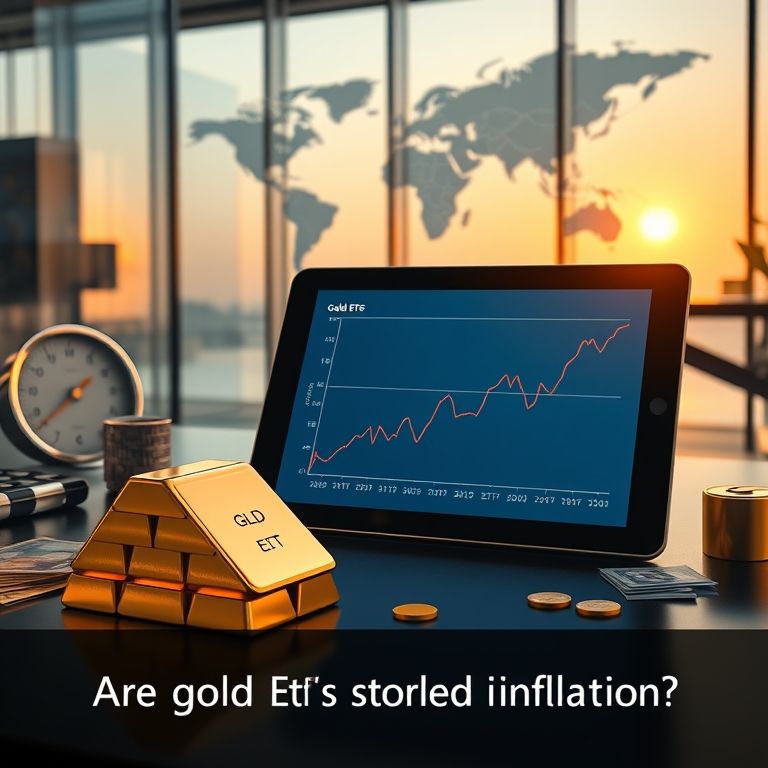Are gold ETFs a good investment during inflation?
Are gold ETFs a good investment during inflation?
Introduction
Inflation nudges every portfolio in the same direction: protect purchasing power without throwing growth out the window. For many traders, gold ETFs feel like a sane, liquid way to add a hedge without handling bullion. But inflation isn’t a single, clear signal; it’s a mix of real yields, currency moves, and risk appetite. This piece walks through what gold ETFs can and cannot do in an inflationary environment, with real-life scenarios, cross-asset comparisons, and a look at how tech, DeFi, and AI spark new opportunities—and new caution flags.

What gold ETFs deliver
- Accessibility and simplicity: One ticker, easy platform access, and the ability to scale up or down quickly as inflation data arrives.
- Liquidity and cost efficiency: Large ETFs trade tightly with low bid-ask spreads and expense ratios often below 0.25%, making them practical for routine hedging or tactical positioning.
- Benchmark exposure with transparency: Most funds track a straightforward price of physical gold or its futures, so you’re not guessing a complex synthetic return.
Inflation dynamics and gold
- Relationship with real yields: When real interest rates are low or negative, gold often shines as a non-yielding asset. As the Fed and other central banks raise rates to fight inflation, real yields may lift, which can cap gold’s upside in the short run.
- Currency and demand cycles: A weaker domestic currency boosts gold in local terms, while stable wide-dollar strength can mute price gains. In practice, inflation spikes followed by stronger dollar phases have produced choppier gold action than a smooth hedge narrative.
Cross-asset view: how gold ETFs compare during inflation
- With forex: Gold tends to hold its own when currencies wobble, giving crude hedging benefits alongside USD correlations. Some traders combine GLD-type exposure with currency pairs to diversify risk.
- In stocks and indices: Gold often moves differently from equities, acting as ballast during drawdowns. Yet a hot inflation print can still pressure both risk-on assets and gold if real yields jump sharply.
- In crypto and commodities: Crypto can offer upside when risk tolerance improves, but it’s a higher-volatility cousin. Gold ETFs sit on the more conservative side, which some traders prefer as a stabilizer in volatile inflationary regimes.
- In options and leverage: Using gold ETFs via options or structured notes can provide leveraged exposure with defined risk, but costs and theta decay add layers to manage.
Reliability and risk factors
- Tracking error and costs: While designed to mimic gold, some funds don’t perfectly track spot price due to management practices and futures roll costs.
- Custody and counterparty risk: Physical-backed ETFs reduce storage hassles but still depend on custodian integrity and trustee protections.
- Market regime risk: In a regime where tech stocks or risk assets rally on growth expectations, gold can underperform even with inflation present.
Practical tips and leverage considerations
- Use a measured slice: Consider 5–15% of your core portfolio in gold ETFs during inflation spikes, adjusting as real yields and inflation expectations move.
- Leverage cautiously: If you’re inclined to leveraged paths, prefer options-based exposure (calls on ultra-short-term volatility, or defined-risk strategies) over outright margin on gold ETFs. Leveraged ETFs exist but bring amplified risk of decays in contango markets.
- Pair with sensible risk controls: set price alerts, use stop-loss or mental stops, and diversify across different gold vehicles (physical vs futures-linked) to avoid single-point risk.
Tech tools and chart analysis
- Build a tech-enabled view: Track real yields, DXY, and inflation surprises alongside gold prices. Use RSI, MACD, and volume signals on a trusted charting platform to spot divergences.
- Chart-driven decisions: If gold breaks above a multi-week resistance with rising volume while inflation prints stay hot, you may adjust exposure modestly. If volatility spikes and real yields jump, lighten positions to preserve capital.
DeFi, decentralization, and the future
- Present state: Tokenized gold and DeFi lending/borrowing concepts promise new, programmable access to gold-like exposure. But custody, price oracles, liquidity fragmentation, and regulatory clarity remain big questions.
- Challenges: Regulating cross-border tokenized assets, ensuring reliable price feeds, and safeguarding against smart contract bugs are top hurdles that slow big adoption.
- Smart contracts and AI-driven trading: The next wave points to smart contract ETFs and tokenized vaults that settle in decentralized ways, paired with AI-driven signal systems for position sizing and risk analytics. The promise is more transparent, programmable hedges—while the risk is new counterparty and model risk in a less-tested environment.
Future trends and best practices
- Smart contracts and automation: Expect more regulated, compliant tokenized gold products with automated settlement and verifiable custody proofs.
- AI-powered decisions: AI tools can sift inflation signals, crypto correlations, and macro surprises to suggest nuanced hedges, but human oversight remains essential to avoid overfitting or false correlations.
- Security and education: Strengthen security with hardware wallets for related token holdings, keep software updated, and stay educated about DeFi risks and gas costs.
Promotional note and closing thought
Gold ETFs offer a steady voice in an inflationary chorus: not a scream, but a measured, reliable line of defense. “Inflation-proof your portfolio with measured exposure.” “Gold ETFs: steadying your balance sheet when the weather turns uncertain.” The bottom line is balance—combine gold exposure with flexible use of other assets (forex, stocks, crypto, indices, options, and commodities) and with thoughtful risk controls. In a world moving toward decentralized finance and AI-assisted trading, gold ETFs remain a practical anchor while you explore the next frontier—carefully, and with a plan that fits your life and risk tolerance.
YOU MAY ALSO LIKE




